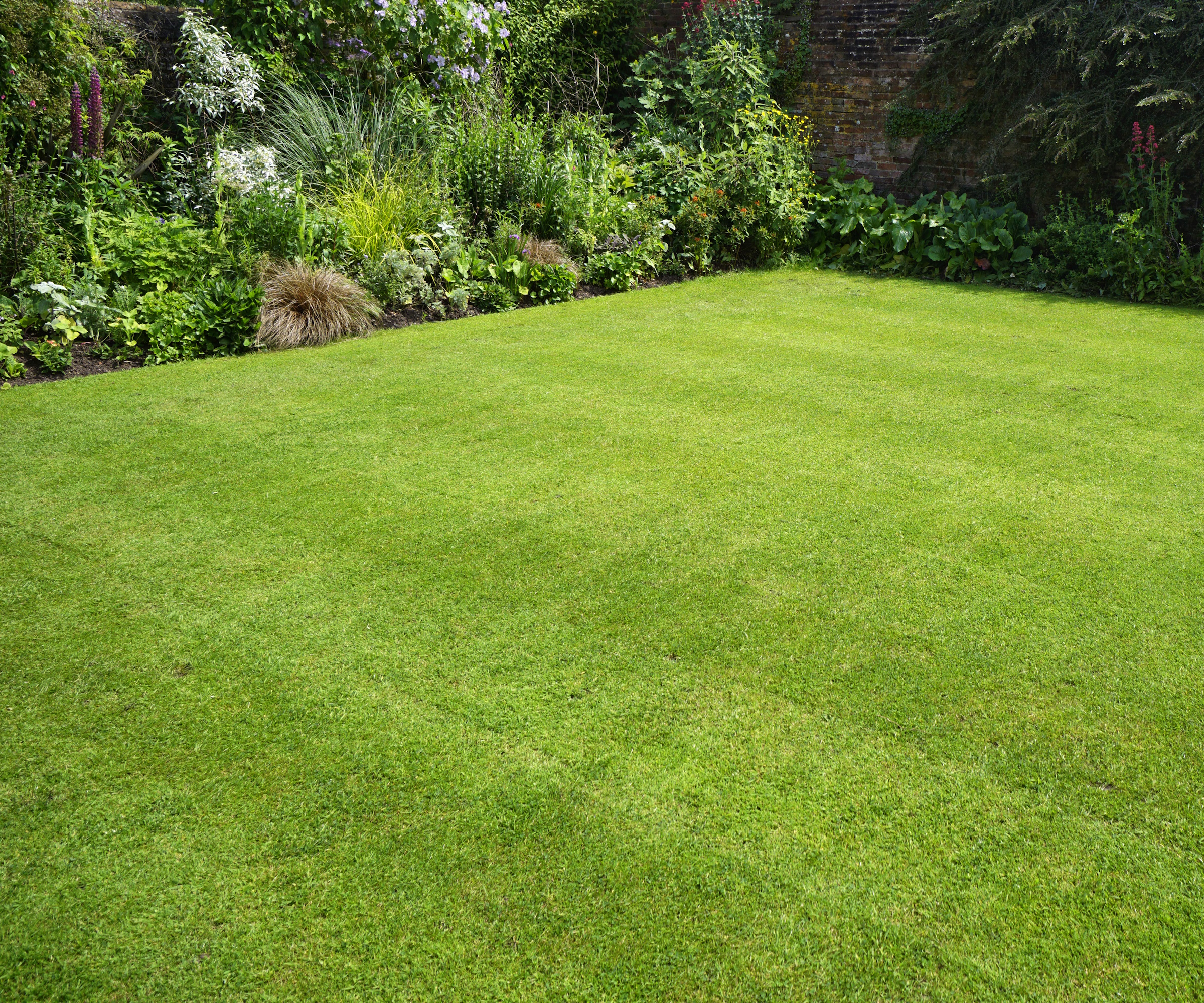What is summer patch? How to identify and combat this destructive lawn disease
A good all-round annual lawn care regime is the best way to avoid summer patch misery


If your lawn has brown patches in summer it could be the result of many things. Lots of these will not be big problems, but if it is summer patch then this fungal disease could pose a major threat to your lawn.
Summer patch disease can be damaging, it attacks grass roots and kills grass. It can be diagnosed by the patches it creates and the root damage on show if you check the affected areas. Do not fret, however, as a good lawn care regime is often a simple and effective way to prevent damage.
Proper diagnosis and preventative action are key to combating summer patch, along with swift action when identified. To help you identify and combat summer patch, we look closely at the signs to look for and what you can do to prevent and treat the fungal disease.

Summer patch can wreak havoc on a green and lush lawn
What is summer patch disease?
Summer patch is caused by the fungus Magnaporthiopsis poae and it predominantly affects grasses in the Poa species. The likes of annual bluegrass, Kentucky bluegrass, and fine fescues are highly susceptible to outbreaks of summer patch.
Signs of summer patch

Summer patch causes bare straw-colored patches to appear on a lawn
Summer patch is a fungus that attacks the root systems of grasses. The disease causes bare patches in a lawn as the fungus prevents the grass from taking in water and nutrients. Small circular patches of dead grass will appear on a lawn and these straw-colored circles will expand in size as the fungus takes hold.
‘You might see a ‘frog eye’ effect, where a healthy-looking patch of grass appears in the center of a brown patch,’ advises Mark Marino from Lawn Phix. ‘The grass at the edges of the patches can take on an orange or bronze hue.’
The patches that appear can be similar to other fungal diseases, such as dollar spot and necrotic ring spot, however, summer patch can be more problematic as the fungus kills the roots as well as the grass. It makes a quick and proper diagnosis important as summer patch can cause major and lasting damage if left untreated.
‘Since summer patch affects the roots, pulling up some affected turf and checking for brown or black roots can confirm the diagnosis,’ says Mark Marino. ‘These symptoms typically become evident when soil temperatures rise above 65°F, particularly during hot, wet summer weather.’
Observation is key to identifying summer patch. Ryan Farley, the CEO of LawnStarter, recommends keeping a close eye on the very first signs of summer patch, which is evidence of dying tips on grass blades. He says: ‘This is typically where the damage starts, and then you will begin to notice it progressing into the more recognizable round patches of dead grass.’

Mark Marino is the owner and operator for Lawn Phix in the state of Massachusetts. He is passionate about nurturing soil health and optimizing turf nutrition, creating an ideal environment for grass to thrive.
Ways to prevent summer patch

Mowing too short can stress a lawn and leave it at risk of summer patch
There are simple ways to make sure that your lawn is less susceptible to summer patch. Having a good care regime and a green and thick lawn is a fantastic way to prevent many fungal diseases, including summer patch.
Mowing: Mowing at the correct height keeps the grass strong and less vulnerable. Cutting the grass too short will stress the grass and make it weaker and more susceptible. Know what mower height is best and never remove more than two-thirds of the length when mowing. Also, ensure that the lawn mower blades are sharp to reduce the risk of fungal diseases taking hold.
Watering: Knowing how and when to water grass properly reduces the risk of summer patch. Dan Bailey, the president of WikiLawn Austin Lawn Care, says: ‘Since summer patch is caused by fungus, the best remedy is to reduce the moisture in the lawn by watering less frequently. When you do water the lawn, water it deeply.’ It is best to water the lawn in the morning and not water the lawn in the evening or at night - as this practise of grass sitting damp overnight encourages the development of fungal diseases.
Aeration and dethatching: These two important spring lawn care tasks will improve the health of the soil and the grass - leaving your lawn less at risk. Soil compaction and the build-up of thatch create an ideal environment for the fungus to thrive in. The practise of aerating and dethatching the lawn annually will boost the lawn’s drainage and airflow, which means a healthy lawn that is less susceptible to summer patch.
Feeding: Fertilizing a lawn is a great way to encourage the development of strong and healthy grass. You want to be careful and pick the best fertilizer for grass in spring and summer. Choose a balanced feed and avoid high-nitrogen products when you fertilize your lawn in spring. Adding too much nitrogen will promote the growth of the grass blades rather than the development of roots. This can lead to stressed grass in the heat of summer with weak roots that can fall victim to the summer patch fungus.
Seeding: When you plant grass seed, choose types that are resistant to summer patch. It might sound like obvious advice, but choosing such disease-resistant varieties stops summer patch from becoming an issue. Any bare patches as a result of the fungus can be overseeded with such cultivars to minimize future reoccurrences, while regular overseeding will help the lawn grow thickly and reduce the risk of summer patch.

Ryan Farley is the CEO of LawnStarter, a lawn care service founded in 2013 and based in Austin, Texas.
How to treat summer patch lawn disease

Always wear gloves when handling fungicides to deal with summer patch
The best preventative summer patch treatment is to maintain a strong and healthy lawn through regular care and maintenance. However, if you do diagnose an infected lawn, there are measures to be able to deal with the issue.
This includes putting down a systemic fungicide treatment that can cure the lawn and prevent future infections. Such a product can also be applied in spring to lawns that have historically had summer patch as a preventative measure. Unfortunately, while chemicals should be a last resort for lawn disease, in most cases fungicides are often the only course of action to avoid summer patch causing lots of damage very quickly.
Fungicides need to be applied when the summer patch fungus is active, which is when the soil temperature is 65°F or higher for three consecutive days. Use a soil thermometer, available at Amazon, for reliable results. As summer patch is a root disease, aerating the lawn ahead of spraying and watering after applying the products will help the product get down into the root zone to target the fungus.
The damaged areas can be reseeded with disease-resistant fast-growing grass seeds, which will be the best grass seed for overseeding a lawn that has been affected by summer patch.

Scotts DiseaseEx Lawn Fungicide prevents disease before it appears and controls disease at the first sign of symptoms. It controls 26 listed lawn diseases and starts to work within 24 hours of application.
FAQs
Does summer patch spread?
If left untreated, the summer patch can spread over a lawn as the fungus grows through the roots. The affected area will get bigger over the summer and the straw-colored bare patches in a lawn can increase by up to 12 inches in diameter over a few weeks.
When to spray for summer patches?
Fungicides for summer patch are either granular, to be spread over the lawn, or come as sprays. The products should be applied once the soil temperature is consistently above 65°F for at least two days. For the best results, apply the fungicide two or three times at intervals of around 28 days.
Funguses can cause many issues for lawns. As well as summer patch, dollar spots, and necrotic ring spots they can also cause fairy rings, lawn rust, and powdery mildew. For all of the fungal problems that can affect grass, good lawn care and maintenance are always the best ways to prevent issues. So don’t take your lawn for granted, give it the TLC it needs to keep the grass lush, green, and healthy.
Sign up to the Homes & Gardens newsletter
Design expertise in your inbox – from inspiring decorating ideas and beautiful celebrity homes to practical gardening advice and shopping round-ups.

Drew’s passion for gardening started with growing vegetables and salad in raised beds in a small urban terrace garden. He has worked as a professional gardener in historic gardens and specialises in growing vegetables, fruit, herbs, and cut flowers as a kitchen gardener. That passion for growing extends to being an allotmenteer, garden blogger, and producing how-to gardening guides for websites. Drew was shortlisted for the New Talent of the Year award at the 2023 Garden Media Guild Awards.
-
 Charred little gem with saffron dressing
Charred little gem with saffron dressingThis recipe with charred little gem is both easy to make and sure to impress guests. It's the perfect side for fresh spring menus
By Alice Hart
-
 Grilled asparagus with herb and pickled red onion
Grilled asparagus with herb and pickled red onionThis grilled asparagus couldn't be easier, and it's a wonderful way to get the best flavor from our favorite spring veg. It's perfect alongside fish or lamb
By Alice Hart

